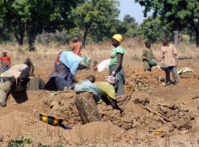-
Africa in Transition // China and the Global Energy Transition // China Environment Forum // Guest Contributor
Lights On or Off? Chinese Solar and Wind Companies in Sub-Saharan Africa
November 21, 2024 By Xiaokang XueWhen I stepped into the bustling exhibition hall at Enlit Africa in Cape Town in May 2024, I was surprised by the riot of colorful banners featuring Chinese characters. A whopping 40% of the exhibitors at one of Africa’s largest energy and power conferences in Cape Town from China—more than any other country.
Perhaps it should not be surprising. China is not only Africa’s largest trading partner and creditor, but also its single largest renewable energy (RE) investor since 2000. Chinese construction companies have built 60% of Sub-Saharan Africa’s (SSA) hydropower plants.
Since electricity access rates are a low 45% in SSA, however, the growth in these renewable investments has been dwarfed by Chinese government loans for large fossil fuel infrastructure projects. China’s smaller-scale private wind and solar investments also have struggled to expand in SSA.
To accelerate the region’s clean energy transition (and their own bottom line), Chinese renewable energy companies need to adopt new financing models, as well as explore innovative local and international partnerships in SSA. The 2024 Forum on China-Africa Cooperation (FOCAC) may have opened just such an opportunity in this space.
Aligned Interests?
China’s overcapacity in renewables and SSA’s energy hunger should be a perfect match. Over the past decade, China has achieved striking domestic growth in wind and solar, with companies accruing abundant experience along the entire supply chain. In 2023, China’s domestic solar production capacity exceeded global demand. And fierce domestic competition has driven Chinese private wind and solar producers and developers to seek international markets.
Xi Jinping banned the construction of new coal plants in 2021. So overseas renewable investment became a new policy focus in the Belt and Road Initiative (BRI), featured in recently published guidelines to green Chinese overseas investment. Policy incentives and investment opportunities also have driven a surge of Chinese wind and solar projects in Southeast Asia since 2021, but a similar boom has gained less traction in SSA.
Despite its needs, Sub-Saharan Africa is finding that its access to renewable energy is limited. While the region generates less than 3% of the world’s renewable electricity, its governments are committed to exploiting their vast renewable potential. But the markets and financing hurdles are considerable.
Obstacles on the Path
The 2021 China-Africa Declaration on Climate Change set guidelines to increase Chinese renewable investments. Unfortunately, both the COVID-19 drag on China’s economy and concerns over a debt crisis in SSA halted Chinese energy financing in 2021 and 2022. Lucas Engel, a data analyst at the Global China Initiative in Boston University’s Global Development Policy Center, observes that while there are “a number of new renewable energy projects,” they “remain a smaller share” of overall investment.
A recent study co-authored by Wei Shen, a research fellow at the Institute of Development Studies, delved deeper into the market obstacles that hinder Chinese renewable projects in SSA. Previously, most Chinese companies operating in SSA’s energy sector were state-owned enterprises (SOEs) undertaking engineering, procurement, and construction (EPC) work. These companies were contractors working for the project developers (usually monopolistic state utilities in the host country) to construct renewable energy systems. Many SOEs secured development financing from Chinese policy banks for these large-scale SAA infrastructure projects. These EPC+Finance contracts are normally government-to-government based transactions—or part of Chinese concessional loan packages.
The shift from fossil fuels to wind and solar energy investments in SSA involves a transition from EPC+Finance to newer mechanisms, such as the Independent Power Producers (IPP). Many SSA governments, including South Africa, created the renewable IPP framework to solicit competitive bids from private companies to build and manage renewable energy projects. (State utilities remain the electricity purchasers). Thus, EPC+Finance is no longer a strong fit for this new model.
Shen noted that “a 20 MW renewable project is considered pretty big in many SSA markets, but considered too small for Chinese SOEs to reach economies of scale.” And while some Chinese private renewable companies are more competitive in the IPP models, they lack the required experience about the SSA market and local contexts. Prominent companies in the renewable market (such as LONGi and Goldwind) have opted to remain as technology providers, and show limited interest in engaging in project development in the SSA region.
Most private Chinese companies also have limited access to financing from Chinese policy banks—mainly CDB and CEXIM—as compared to SOEs. And the prevailing debt crisis and political instability across the SSA region make these banks hesitant to finance large-scale projects including renewable energy systems.
Green Shoots on the Horizon?
What’s changing now? Well, the 2024 FOCAC seemed to chart a clearer path, with 30 green projects pledged and a declaration reaffirming China’s commitment to renewable investment in Africa. The updated action plan adopted at the forum emphasized a shift from megaprojects to “small yet beautiful” initiatives, aimed at fostering innovative financing methods. What’s more, SOEs are actively working to expand their roles within the IPP model, including a recent agreement signed at the Luderitz wind plant in Namibia.
This new momentum provides an excellent starting point for China to better align its overseas investment portfolio with Africa’s growing renewable energy needs. The Chinese government could build on this further by introducing flexible financing products including blended finance and other innovative de-risking instruments. China’s Ministry of Commerce and the BRI International Green Development Coalition might also help companies navigate overseas markets by publishing guidelines and offering capacity-building training. Additionally, Chinese companies can expand financing sources and explore new project opportunities by partnering with international and SSA multilateral development banks. For companies hesitant about large-scale project financing, collaborating with international and local businesses in SSA can provide more EPC opportunities and operational roles. There may even be paths to scale distributed solar solutions, if the Chinese government incentivizes private firms experienced in China’s fast-growing solar sector to explore similar opportunities in SSA’s rural areas.
This blog is part of the China Environment Forum’s China and the Global Energy Transition project that is exploring China’s role in promoting a clean energy transition in the Global South.
Xiaokang Xue was a summer 2024 research intern at the China Environment Forum. Originally from China, he is a senior at Brown University, concentrating in Environmental Science and Applied Math-Economics. He studied abroad at the University of Cape Town in spring 2024. His research focuses on international climate policy, development finance, and South-South cooperation to address climate change.
Sources: African Business, African Climate Foundation, Africa Defense Forum, African Development Bank Group, Boston University Global Development Policy Center, Carbon Brief, CNN, Energy Foundation China, Enlit Africa, European Investment Bank, Forum on China-Africa Cooperation, German Institute for International and Security Affairs, Goldwind, International Energy Agency, International Institute for Strategic Studies, International Renewable Energy Agency, London School of Economics and Political Science, LONGi, Ministry of Foreign Affairs of PRC, National Development and Reformation Commission, NIPPC, PWC, Reuters, Scientific African, South China Morning Post USAID, World Development, World Economic Forum, World Resources Institute, Xinhua, Yale Environment 360
Photo Credit: The 2024 FOCAC Summit Opening Ceremony | Beijing, 5 September 2024 by Paul Kagame / flickr.com. Licensed under CC BY-NC-ND 2.0.
 A Publication of the Stimson Center.
A Publication of the Stimson Center.









